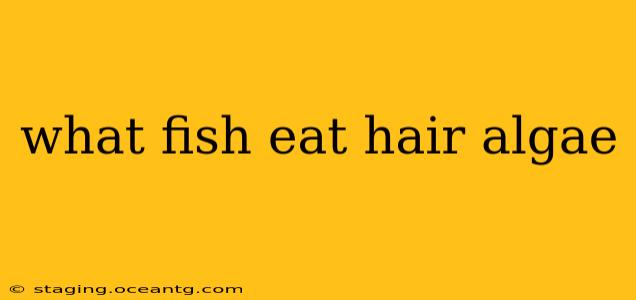What Fish Eat Hair Algae? A Guide to Biological Aquarium Cleaning
Hair algae, those annoying stringy green growths that plague aquariums, can be a real headache for fish keepers. Luckily, several fish species are natural algae eaters and can help keep your tank clean and aesthetically pleasing. Choosing the right fish depends on the size of your tank and the type of algae you're dealing with. Let's dive into some popular options and address some common questions.
What types of algae do fish eat?
Many fish species graze on various types of algae, including hair algae. However, it's important to note that no single fish will completely eradicate all algae. Different fish have different preferences, and some are more effective at controlling certain types of algae than others. For example, some fish may target filamentous algae like hair algae more effectively than other forms like diatoms or green spot algae. A multi-pronged approach, combining fish with other methods like proper water parameters and regular maintenance, is often the most successful strategy.
What are some of the best fish for eating hair algae?
Several fish species are known for their appetite for hair algae. However, remember to research the specific needs of each fish before introducing them to your tank. Consider tank size and compatibility with other inhabitants. Here are some popular choices:
-
Siamese Algae Eaters (SAE): These fish are highly regarded for their effectiveness against hair algae. They are relatively small and peaceful, making them suitable for community tanks. However, they can become picky eaters as they mature, potentially losing their interest in algae.
-
Otocinclus Catfish (Oto): These small, peaceful catfish are excellent algae grazers. They are particularly effective at cleaning glass and decorations, often reaching areas other fish miss. They require soft, slightly acidic water, so ensure your tank parameters are suitable.
-
Amano Shrimp: While not fish, Amano shrimp are incredibly efficient algae eaters, including hair algae. They are peaceful and thrive in community tanks. They require a well-established tank and are sensitive to water changes.
-
Nerite Snails: Another non-fish option, Nerite snails are prolific algae eaters and will happily munch on hair algae. They are relatively low maintenance and help control various algae types.
How many algae-eating fish should I add to my tank?
The number of algae-eating fish you need depends on the size of your tank and the severity of the algae problem. It's better to start with a smaller number and add more if necessary, rather than overcrowding your tank. Overstocking can lead to stress, disease, and poor water quality. Research the specific needs of the chosen species to determine the appropriate stocking density.
Will algae-eating fish eat all the algae in my tank?
While algae-eating fish can significantly reduce hair algae populations, they are unlikely to eliminate it completely. Algae growth is influenced by many factors, including light, nutrients, and water parameters. Maintaining proper water conditions and regular tank maintenance is crucial for long-term algae control. Think of these fish as part of a comprehensive algae management strategy rather than a miracle cure.
What if my algae-eating fish are not eating the algae?
Several factors can influence why your algae-eating fish might not be consuming the hair algae as expected. This can include:
- Diet: Some fish might prefer other food sources, especially if readily available. Ensure they are getting sufficient algae-based food.
- Water Quality: Poor water parameters can stress your fish, reducing their appetite. Regularly test your water and ensure it's within the optimal range.
- Algae Type: The specific type of algae might not be palatable to your fish. Some fish are more selective than others.
- Age: SAE, in particular, can become less effective algae eaters as they age.
By addressing these factors and possibly introducing complementary algae control measures, you can enhance the effectiveness of your algae-eating fish. Remember that a combination of approaches often works best for long-term success.
By carefully considering your tank environment and choosing the right fish (or invertebrates), you can effectively combat hair algae and maintain a beautiful, healthy aquarium. Remember to research the specific needs of your chosen species to ensure they thrive in your tank.
